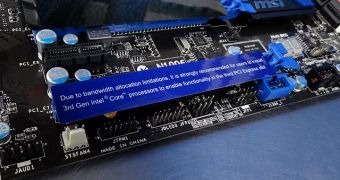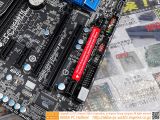As information stickers on new Z77 motherboards show, builders of Z77-based systems will need an Ivy Bridge CPU to make one of the long PCIe slots work.
This is quite strange as it’s the first time we’re presented with a disabled PCIe x16 slot on a wide range of high-end PC motherboards.
Whether that's the case is unclear but very likely. The third long PCIe x16 slot from most of the motherboards might not work at all. That is to say, it won't work even with a device that doesn’t need too much bandwidth, like a sound card or a TV tuner.
If we were to take a close look at the block diagram of the Intel Z77 Express chipset, we can easily notice that the chipset has a single PCIe x16 link.
These 16 lanes can be configured in three ways: x16/NC/NC; x8/x8/NC and x8/x4/x4.
Intel considered that they should take advantage of the high bandwidth the 3rd generation of the PCI-Express standard has to offer.
If a PCIe lane in PCI-Express v.1.0 can carry 250 MB/s in each direction, and a PCI-Express v.3.0 lane can carry 1 GB/s in each direction, then a 4 lane PCIe 3.0 slot will have roughly the same bandwidth as a 16 lane PCIe 1.0 slot.
Physically, the slots on the motherboard look the same, but electrically, 4x PCI-Express 3.0 has the same bandwidth as a 16x PCI-Express 1.0 had back in the days of 2004.
Therefore, if you plan on buying a future-proof motherboard with a Z77 chipset but only have the money for a cheap Sandy Bridge CPU, keep in mind that if you ever save the funds for a triple-SLI or triple-CrossFireX setup, you’ll need money for an Ivy Bridge CPU as well.

 14 DAY TRIAL //
14 DAY TRIAL // 
